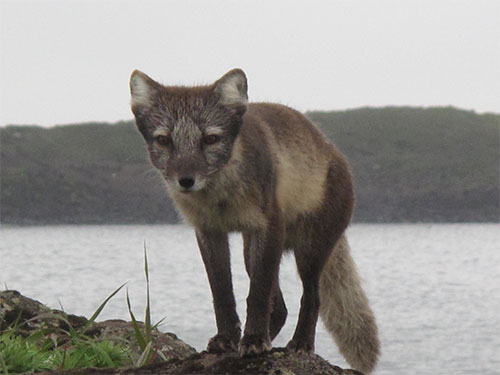Alaska Science Rabies endures in Alaska with help of the arctic foxBy NED ROZELL
October 23, 2016
"We don't have a really good answer to that," said UAF's Karsten Hueffer. "It probably has to do with the long incubation time of the virus, which can be months." Hueffer and his colleagues, including four university undergraduate students, wrote a paper on how Alaska's arctic foxes might be the carrier that keeps the disease present all the time in the western part of the state. Red foxes also get infected with rabies and pass it on, but the virus may not endure in their populations. In a future with less arctic foxes and more of the dominant reds, rabies might be on the wane in Alaska.
An arctic fox on St. Paul Island. p Scientists noted a constant presence of rabies virus in the coastal tundra home of the arctic fox. Interior forests inhabited by only the red fox seem to only have sporadic outbreaks of rabies. The researchers did their genetic testing of arctic and red foxes across Alaska using hundreds of flesh samples from biologists, trappers and museum collectors. They found the genetic makeup of arctic foxes followed the genetics of the virus. Red foxes showed a weaker connection. Foxes spread rabies by biting. The virus rides in their saliva and invades other animals through wounds or mucous membranes. After incubation periods that last from eight days to six months, foxes can lose their natural timidity, sometimes attacking dogs and infecting them. Dogs with the virus can spread it to people. Rabies vaccine can save people, but it has to be taken right after infection. Animals need routine vaccinations to prevent infections. There is no good treatment for rabies. Rabid animals become paralyzed and die. Before the genetic study, scientists thought that rabies perhaps came to Alaska via infected foxes wandering over from Canada or Russia. Strains that walked over the border in foxes might have disappeared in Alaska after a while. But now they think the virus never goes away, living on within infected arctic foxes of Alaska's west coast and the Aleutians. Because arctic foxes are adapted to life on and around sea ice, they are facing greater changes than the larger and more dominant red fox. If a shrinking habitat and bullying by the red fox greatly reduces the numbers of the arctic fox, rabies in Alaska might decrease along with the small canine that turns white each winter. On a marginally related subject, August 2016 was the eleventh month in a row that featured temperatures above normal in Alaska. In his summary for the month, Blake Moore of the Alaska Climate Research Center wrote that all 19 of the official weather stations in places from Annette (Ketchikan) to Barrow showed above-normal mean daily temperatures all 31 days of the month. Different places in Alaska broke temperature records 34 times during August. All but one of those new records was for a new high, like McGrath's 73 F on the 31st, King Salmon's 76 on the 27th and St. Paul's 59 on the 29th. St. Paul also had the only record low for the month, with a 37 on August 2.
Representations of fact and opinions in comments posted are solely those of the individual posters and do not represent the opinions of Sitnews.
|
||

